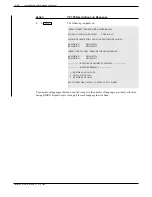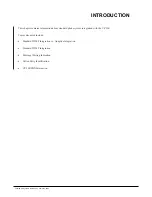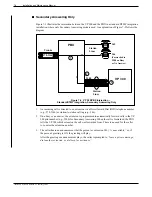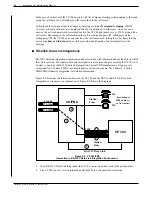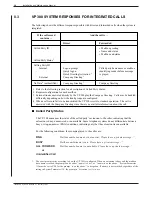
■
Secondary Answering Only
Figure 7-2 illustrates the interaction between the VP 300 and the PBX in a standard DTMF integration
installation, where only Secondary Answering mode is used. An explanation of Figure 7-2 follows the
diagram.
1.
An incoming call is directed to an extension via a Direct Inward Dial (DID) telephone number
(e.g., 578-3346) or station-to-station calling (e.g., 346).
2.
On a busy or no answer, the extension is programmed to automatically forward calls to the VP
300 pilot number (e.g., 2500) for Secondary Answering. When the call is forwarded, the PBX
tells the VP 300 which extension the call was forwarded from. There is no need for the caller
to re-enter the extension number.
3.
The caller hears an announcement that the person (or extension 346) “is unavailable,” or, if
the person's greeting is ON, the greeting will play.
After the greeting or announcement plays, the caller is prompted to “leave a private message,
dial another extension, or dial zero for assistance.”
Toshiba VP Systems Release 6.1 February, 1993
7-4
Installation and Maintenance Manual
1
345
346
PBX
Trunks
VP 300
2500
Figure 7-2 VP 300/PBX Interaction –
Standard DTMF Integration, Secondary Answering Only
(Forwarded to
2500 on Busy
or No Answer)
Station
Lines
Station
Lines
2
3
578-3346
Summary of Contents for VP 300
Page 2: ......
Page 10: ......
Page 14: ......
Page 20: ...Toshiba VP Systems Release 7 1 July 1994 ...
Page 52: ...Toshiba VP Systems Release 6 1 February 1993 2 14 Installation and Maintenance Manual ...
Page 56: ...Toshiba VP Systems Release 7 1 July 1994 ...
Page 146: ......
Page 312: ...Toshiba VP Systems Release 7 1 July 1994 ...
Page 314: ......
Page 444: ......
Page 496: ......
Page 542: ......
Page 598: ...Toshiba VP Systems Release 6 1 February 1993 ...
Page 600: ...Toshiba VP Systems Release 6 1 February 1993 ...









